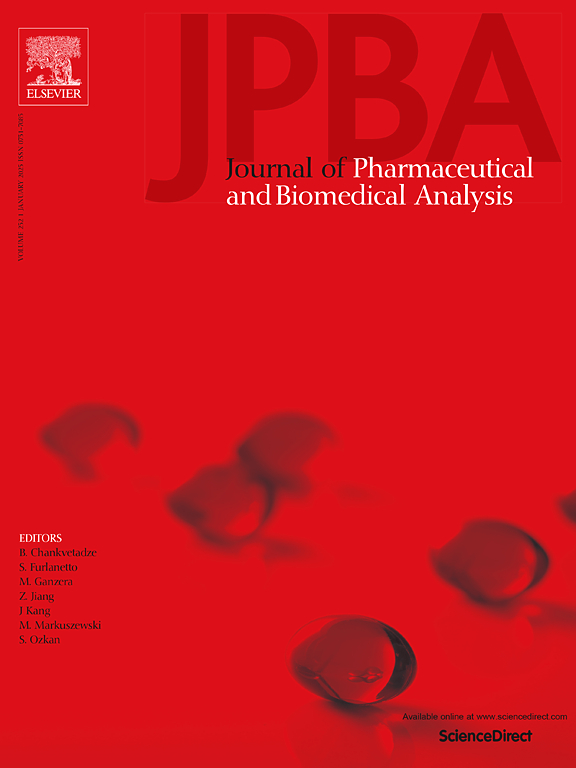Unique methotrexate polyglutamates distributions in peripheral blood mononuclear cells of rheumatoid arthritis patients: Development and validation of a UPLC-MS/MS method
IF 3.1
3区 医学
Q2 CHEMISTRY, ANALYTICAL
Journal of pharmaceutical and biomedical analysis
Pub Date : 2025-04-08
DOI:10.1016/j.jpba.2025.116882
引用次数: 0
Abstract
Methotrexate is pivotal in treating immune-mediated inflammatory diseases. Intracellularly, methotrexate is metabolized to methotrexate-polyglutamates (MTX-PG1–7), comprising up to six additional glutamate moieties, crucial for cellular retention and therapeutic efficacy. Hitherto, quantification of MTX-PG1–6 in peripheral blood mononuclear cells (PBMCs) from methotrexate-treated patients was challenging due to their low abundance in blood and matrix effects. We present a robust validated UPLC-MS/MS method to quantify individual MTX-PG1–6 in PBMCs. Stable-isotope labelled internal standard mixture of MTX-PG1–6 was added to 5 million PBMCs, followed by deproteinization with perchloric acid, and additional sample clean-up using solid phase extraction columns. MTX-PG1–6 were detected and quantified using UPLC-MS/MS. The method was validated for lower limit of quantification (LLOQ), linearity, carryover, recovery, matrix effects, precision and stability. We assessed MTX-PG1–6 in PBMCs derived from five methotrexate-treated rheumatoid arthritis patients. For all MTX-PG1–6, LLOQs were < 1 fmol-MTX-PG1–6/million cells with linearities R2 > 0.995. The recoveries, carryover and stability were acceptable and no matrix effects were observed. The intraday and interday precision %CVs of quality controls ranged from 2.7 % to 11.4 % and 3.5–14.9 % respectively. Interday precision using nine PBMCs aliquots from a single MTX-treated patient aligned similarly (%CV <15 %). In patient-derived PBMC samples, MTX-PG1 was the highest, with decreasing concentrations of MTX-PG2 to MTX-PG5. No signal for MTX-PG6 was detected in the patient samples. We validated a new UPLC-MS/MS method to quantify MTX-PG1–6 in PBMCs, thus facilitating PBMC-based therapeutic drug monitoring studies and understand associations between MTX-PG1–6 concentration and therapy efficacy or adherence.
类风湿关节炎患者外周血单个核细胞中独特的甲氨蝶呤多谷氨酸分布:UPLC-MS/MS方法的开发和验证
甲氨蝶呤是治疗免疫介导的炎症性疾病的关键。在细胞内,甲氨蝶呤被代谢为甲氨蝶呤-多谷氨酸(MTX-PG1-7),包括多达6个额外的谷氨酸片段,对细胞保留和治疗效果至关重要。迄今为止,甲氨蝶呤治疗患者外周血单个核细胞(PBMCs)中MTX-PG1-6的定量具有挑战性,因为它们在血液和基质中的丰度较低。我们提出了一种可靠的UPLC-MS/MS方法来定量pbmc中单个MTX-PG1-6。将稳定同位素标记的MTX-PG1-6内标混合物加入500万pbmc中,然后用高氯酸脱蛋白,并用固相萃取柱进行额外的样品清理。采用UPLC-MS/MS检测并定量MTX-PG1-6。对该方法的定量下限、线性、残留、回收率、基质效应、精密度和稳定性进行了验证。我们评估了5例接受甲氨蝶呤治疗的类风湿关节炎患者外周血中MTX-PG1-6的含量。所有MTX-PG1-6的lloq为<; 1 /million cells,线性关系R2 >; 0.995。加样回收率、结转率和稳定性良好,无基质效应。日内、日间精密度cv分别为2.7 % ~ 11.4 %和3.5 ~ 14.9 %。使用来自单个mtx治疗患者的9个pbmc的日间精度排列相似(%CV <15 %)。在患者来源的PBMC样本中,MTX-PG1浓度最高,MTX-PG2浓度降低至MTX-PG5。患者样本中未检测到MTX-PG6的信号。我们验证了一种新的UPLC-MS/MS方法来定量pbmc中MTX-PG1-6,从而促进基于pbmc的治疗药物监测研究,并了解MTX-PG1-6浓度与治疗疗效或依从性之间的关系。
本文章由计算机程序翻译,如有差异,请以英文原文为准。
求助全文
约1分钟内获得全文
求助全文
来源期刊
CiteScore
6.70
自引率
5.90%
发文量
588
审稿时长
37 days
期刊介绍:
This journal is an international medium directed towards the needs of academic, clinical, government and industrial analysis by publishing original research reports and critical reviews on pharmaceutical and biomedical analysis. It covers the interdisciplinary aspects of analysis in the pharmaceutical, biomedical and clinical sciences, including developments in analytical methodology, instrumentation, computation and interpretation. Submissions on novel applications focusing on drug purity and stability studies, pharmacokinetics, therapeutic monitoring, metabolic profiling; drug-related aspects of analytical biochemistry and forensic toxicology; quality assurance in the pharmaceutical industry are also welcome.
Studies from areas of well established and poorly selective methods, such as UV-VIS spectrophotometry (including derivative and multi-wavelength measurements), basic electroanalytical (potentiometric, polarographic and voltammetric) methods, fluorimetry, flow-injection analysis, etc. are accepted for publication in exceptional cases only, if a unique and substantial advantage over presently known systems is demonstrated. The same applies to the assay of simple drug formulations by any kind of methods and the determination of drugs in biological samples based merely on spiked samples. Drug purity/stability studies should contain information on the structure elucidation of the impurities/degradants.

 求助内容:
求助内容: 应助结果提醒方式:
应助结果提醒方式:


